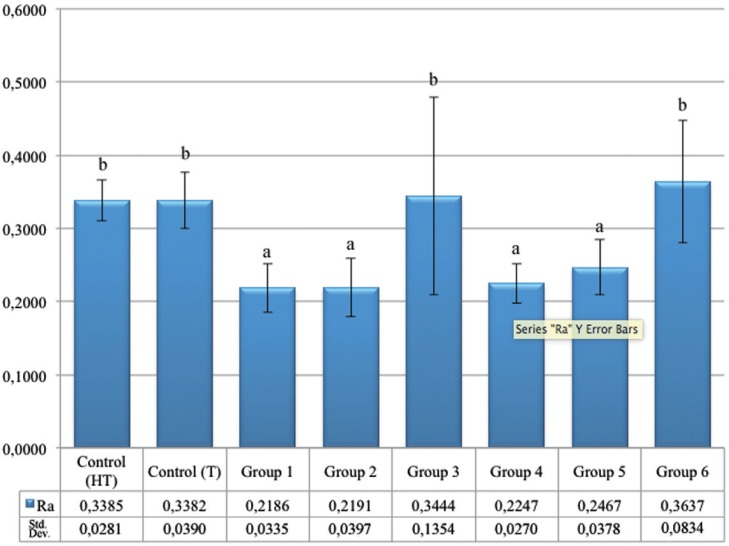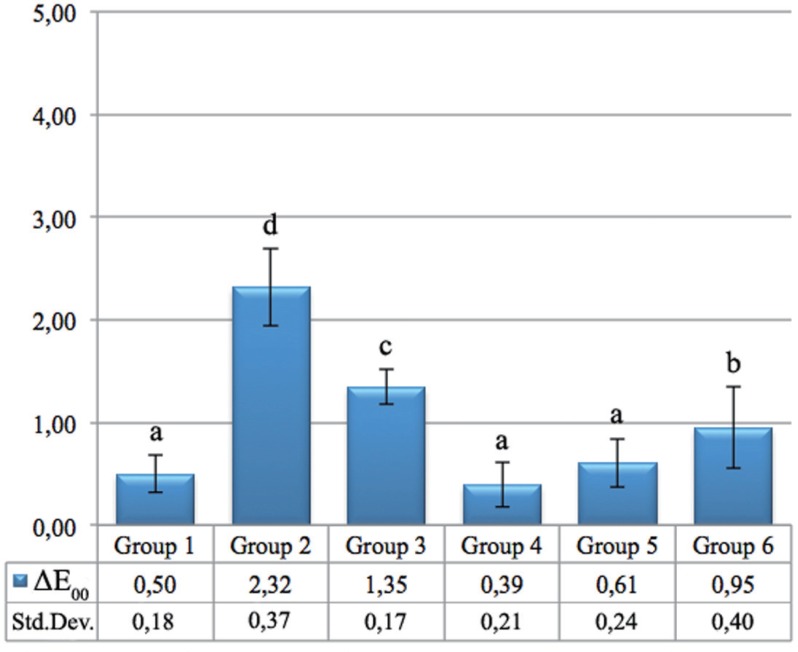J Adv Prosthodont.
2016 Feb;8(1):16-20. 10.4047/jap.2016.8.1.16.
Effects of different surface finishing procedures on the change in surface roughness and color of a polymer infiltrated ceramic network material
- Affiliations
-
- 1Department of Prosthodontics, Faculty of Dentistry, Akdeniz University, Antalya, Turkey. sbuyukkaplan@akdeniz.edu.tr
- 2Department of Restorative Dentistry, Faculty of Dentistry, Akdeniz University, Antalya, Turkey.
- KMID: 2393191
- DOI: http://doi.org/10.4047/jap.2016.8.1.16
Abstract
- PURPOSE
Polymer infiltrated ceramic network (PICN) materials, also called hybrid ceramics, are new materials in dental market. The manufacturer of the PICN material VITA Enamic suggests 3 different finishing procedures for this new material. In the present study, surface roughness and color differences caused from different finishing procedures of VITA Enamic were investigated.
MATERIALS AND METHODS
120 specimens were prepared in dimensions 2 x 10 x 12 mm from VITA Enamic hybrid ceramic blocks with 'high translucency' and 'translucency 2M2' shades. The specimens were divided into 8 groups. For each group, different finishing procedures suggested by the manufacturer were performed. Surface roughness values were determined by a tactile portable profilometer. Color changes were evaluated using a clinical spectrophotometer. The data were analyzed using one-way ANOVA and Tukey's post-hoc comparison. The significance level was set at alpha=0.05.
RESULTS
The roughest surfaces were observed in Glaze Groups. Their surface roughness values were similar to that of the control group. Clinical Kit and Technical Kit groups did not show a statistically significant difference regarding surface roughness (P>.05). The largest color difference regarding DeltaE00 was observed in Clinical Kit finishing groups. There were also statistically significant color changes between the groups (P<.05). However, all the groups showed clinically acceptable color change (DeltaE(00)<2.25) except Clinical Kit Groups (DeltaE(00)>2.25).
CONCLUSION
Within the limitations of the present study, it may be suggested that finishing the VITA Enamic restorations by Technical Kit instead of Glaze and Clinical Kit gives better clinical performance in regard to surface roughness and shade matching.
Figure
Cited by 1 articles
-
Surface deterioration of monolithic CAD/CAM restorative materials after artificial abrasive toothbrushing
Nazmiye Şen, Betül Tuncelli, Gültekin Göller
J Adv Prosthodont. 2018;10(4):271-278. doi: 10.4047/jap.2018.10.4.271.
Reference
-
1. Della Bona A, Corazza PH, Zhang Y. Characterization of a polymer-infiltrated ceramic-network material. Dent Mater. 2014; 30:564–569. PMID: 24656471.
Article2. Coldea A, Swain MV, Thiel N. In-vitro strength degradation of dental ceramics and novel PICN material by sharp indentation. J Mech Behav Biomed Mater. 2013; 26:34–42. PMID: 23807311.
Article3. He LH, Swain M. A novel polymer infiltrated ceramic dental material. Dent Mater. 2011; 27:527–534. PMID: 21371744.
Article4. Nguyen JF, Ruse D, Phan AC, Sadoun MJ. High-temperature-pressure polymerized resin-infiltrated ceramic networks. J Dent Res. 2014; 93:62–67. PMID: 24186559.
Article5. Ghinea R, Pérez MM, Herrera LJ, Rivas MJ, Yebra A, Paravina RD. Color difference thresholds in dental ceramics. J Dent. 2010; 38:e57–e64. PMID: 20670670.
Article6. Coldea A, Swain MV, Thiel N. Mechanical properties of polymer-infiltrated-ceramic-network materials. Dent Mater. 2013; 29:419–426. PMID: 23410552.
Article7. Coldea A, Swain MV, Thiel N. Hertzian contact response and damage tolerance of dental ceramics. J Mech Behav Biomed Mater. 2014; 34:124–133. PMID: 24566383.
Article8. Bottino MA, Campos F, Ramos NC, Rippe MP, Valandro LF, Melo RM. Inlays made from a hybrid material: adaptation and bond strengths. Oper Dent. 2015; 40:E83–E91. PMID: 25405903.
Article9. van der Burgt TP, ten Bosch JJ, Borsboom PC, Kortsmit WJ. A comparison of new and conventional methods for quantification of tooth color. J Prosthet Dent. 1990; 63:155–162. PMID: 2304021.
Article10. Uludag B, Usumez A, Sahin V, Eser K, Ercoban E. The effect of ceramic thickness and number of firings on the color of ceramic systems: an in vitro study. J Prosthet Dent. 2007; 97:25–31. PMID: 17280888.
Article11. Monasky GE, Taylor DF. Studies on the wear of porcelain, enamel, and gold. J Prosthet Dent. 1971; 25:299–306. PMID: 5276853.
Article12. Jung YS, Lee JW, Choi YJ, Ahn JS, Shin SW, Huh JB. A study on the in-vitro wear of the natural tooth structure by opposing zirconia or dental porcelain. J Adv Prosthodont. 2010; 2:111–115. PMID: 21165280.13. Fasbinder DJ, Neiva GF. Surface Evaluation of Polishing Techniques for New Resilient CAD/CAM Restorative Materials. J Esthet Restor Dent. 2015; 7. 14.
Article14. Haghi HR, Asadzadeh N, Sahebalam R, Nakhaei M, Amir JZ. Effect of denture cleansers on color stability and surface roughness of denture base acrylic resin. Indian J Dent Res. 2015; 26:163–166. PMID: 26096110.
Article15. Roque AC, Bohner LO, de Godoi AP, Colucci V, Corona SA, Catirse AB. Surface roughness of composite resins subjected to hydrochloric acid. Braz Dent J. 2015; 26:268–271. PMID: 26200151.
Article
- Full Text Links
- Actions
-
Cited
- CITED
-
- Close
- Share
- Similar articles
-
- The effect of repeated firings on the color change and surface roughness of dental ceramics
- Comparative color and surface parameters of current esthetic restorative CAD/CAM materials
- Comparative study of surface roughness between several finishing and polishing procedures on ormocer-based composite resin and nanohybrid composite resin
- A study on surface roughness of metals according to finishing and polishing procedures: an atomic force microscope analysis
- Surface Roughness and Microbial Adhesion After Finishing of Alkasite Restorative Material



